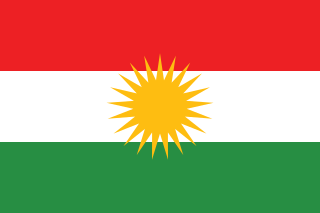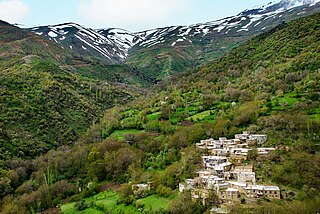
Kurds or Kurdish people are an Iranic ethnic group native to the mountainous region of Kurdistan in Western Asia, which spans southeastern Turkey, northwestern Iran, northern Iraq, and northern Syria. There are exclaves of Kurds in Central Anatolia, Khorasan, and the Caucasus, as well as significant Kurdish diaspora communities in the cities of western Turkey and Western Europe. The Kurdish population is estimated to be between 30 and 45 million.

The Kurds are an Iranian ethnic group in the Middle East. They have historically inhabited the mountainous areas to the south of Lake Van and Lake Urmia, a geographical area collectively referred to as Kurdistan. Most Kurds speak Northern Kurdish Kurmanji Kurdish (Kurmanji) and Central Kurdish (Sorani).

Kurdistan or Kordestan province is one of the 31 provinces of Iran. The province is 28,817 km2 in area and its capital is the city of Sanandaj. Other counties with their major cities are Saqqez, Baneh, Marivan, Qorveh, Bijar, Kamyaran, Dehgolan, Diwandarreh and Sarvabad.

Tawûsî Melek is one of the central figures of the Yazidi religion. In Yazidi creation stories, before the creation of this world, God created seven Divine Beings, of whom Tawûsî Melek was appointed as the leader. God assigned all of the world's affairs to these seven Divine Beings, also often referred to as the Seven Angels or heft sirr.

Yazidism, alternatively Sharfadin, is a monotheistic ethnic religion that has roots in a western Iranic pre-Zoroastrian religion directly derived from the Indo-Iranian tradition. It is followed by the mainly Kurdish-speaking Yazidis and is based on belief in one God who created the world and entrusted it into the care of seven Holy Beings, known as Angels. Preeminent among these Angels is Tawûsî Melek, who is the leader of the Angels and who has authority over the world.

Kurdish literature is literature written in the Kurdish languages. Literary Kurdish works have been written in each of the four main languages: Zaza, Gorani, Kurmanji and Sorani. Ali Hariri (1009–1079) is one of the first well-known poets who wrote in Kurdish. He was from the Hakkari region.
Minorities in Iraq include various ethnic and religious groups.
Yazdânism, or the Cult of Angels, is a pseudohistoric pre-Islamic religion with claimed ties relating to a Mithraic religion of the Kurds. The term was introduced and proposed by Kurdish and Belgian scholar Mehrdad Izady to represent what he considers the "original" religion of the Kurds.
Religion in Iraq dates back to Ancient Mesopotamia, particularly Sumer, Akkad, Assyria and Babylonia between circa 3500 BC and 400 AD, after which they largely gave way to Syriac Christianity and later to Islam.

Rawwadid, Ravvadid, or Banū Rawwād (955–1071) was a Sunni Muslim Kurdish dynasty, centered in the northwestern region of Adharbayjan (Azerbaijan) between the late 8th and early 13th centuries.
According to the most recent government statistics, 97% of the population of Iraq was Muslim in 2010 ; the constitution states that Islam is the official religion of the country.

Abū Maymūn Jābān al-Kurdī, also referred to as Jaban Sahabi, was a reputed companion of the Islamic prophet Muhammad. Jābān was of Kurdish ethnicity.

Yazidis or Yezidis are a Kurdish-speaking endogamous religious group who are indigenous to Kurdistan, a geographical region in Western Asia that includes parts of Iraq, Syria, Turkey and Iran. The majority of Yazidis remaining in the Middle East today live in Iraq, primarily in the governorates of Nineveh and Duhok.

The Sinjar District or the Shingal District is a district of the Nineveh Governorate. The district seat is the town of Sinjar. The district has two subdistricts, al-Shemal and al-Qayrawan. The district is one of two major population centers for Yazidis, the other being Shekhan District.

The main religions that exist or historically existed in Kurdistan are as follows: Sunni Islam, Shia Islam, Christianity, Zoroastrianism, Yarsanism, Yazidism, Alevism and Judaism. Overall today, Sunni Islam is the most adhered to religion in Kurdistan.

Kurds in Jordan refers to people born in or residing in Jordan who are of Kurdish origin. The Kurdish population in Jordan is approximately 30,000 and they mainly live in the cities of Amman, Irbid, Salt and Zarqa. The approximately 100 years old community are almost completely integrated into the Jordanian society. Because of the integration of the Kurdish community, they do not have a granted seat in the Parliament of Jordan.
Kurdish-Islamic synthesis, or Kurdish-Islamic nationalism is a form of Kurdish nationalism which is Islamist in nature, unlike mainstream Kurdish nationalism, which is secularist in nature.
Kurdish Muslims are Kurds who follow Islam, which is the largest religion among Kurds and has been for centuries. Kurds largely became Muslims in the 7th century.











